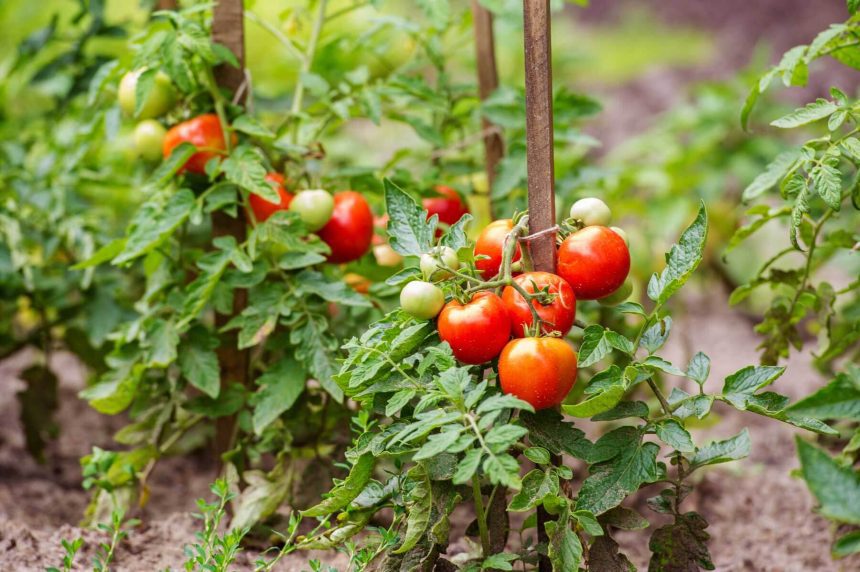Tomatoes are one of the most popular garden crops and are delicious eaten fresh and incorporated into all kinds of recipes. But did you know that certain companion plants can help your tomato plants be more productive, healthy and yield more tomatoes? Choosing the right plants to grow alongside your tomatoes can bring benefits like enhancing flavor, deterring pests, attracting beneficial insects, improving soil nutrients and much more.
The Benefits of Companion Planting
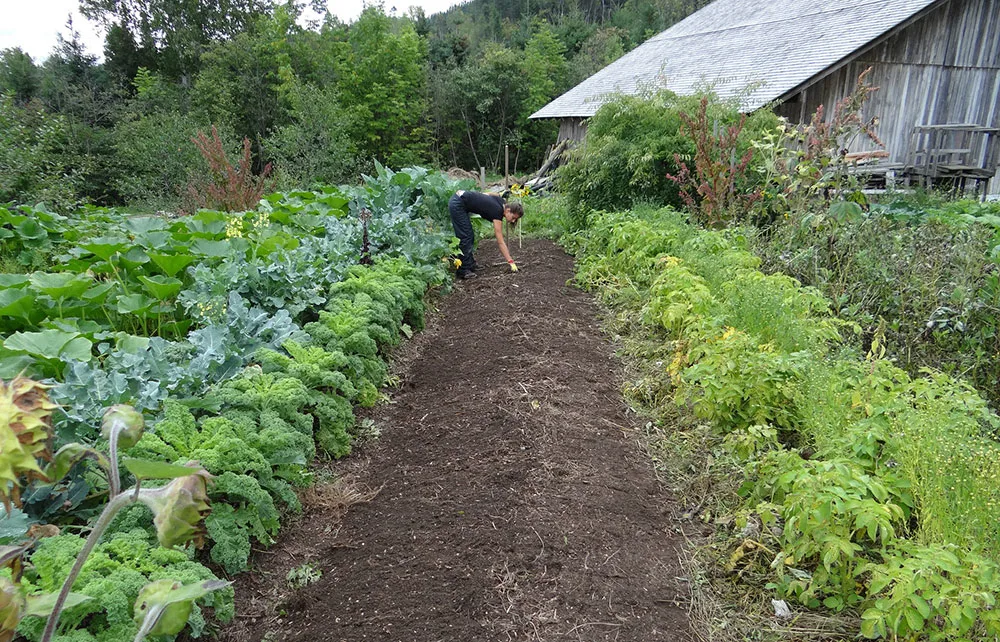
Companion planting leverages the unique ways plants interact via their roots, foliage, natural pest resistance and other mechanisms. When done thoughtfully, interplanting vegetables, herbs and flowers creates a symbiotic polyculture environment.
Some key benefits this intercropping provides for tomatoes and their companion plants are:
- Pest Confusion & Deterrence – Companions mask the scent of tomatoes, making it harder for pests to establish themselves. Some give off repellent odors.
- Enhancing Flavor – Some companions like basil, borage, thyme and oregano seem to improve tomato taste and aroma.
- Attracting Beneficial Insects – Flowers provide pollen and nectar food sources for predatory and parasitic insects that prey upon common tomato pests.
- Improving Soil Nutrients & Structure – Through nutrient uptake differences and root depths, efficient use of nutrients results. Some plants help suppress weeds.
- Nurse Plant Effects – Low spreading plants provide shade for tomato plant roots and maintain moisture. Some attract helpful soil microbes.
Getting these symbiotic effects right allows the gardener to create a diverse, resource-efficient and largely self-sustaining planting environment.
Best Herb Companion Plants for Tomatoes
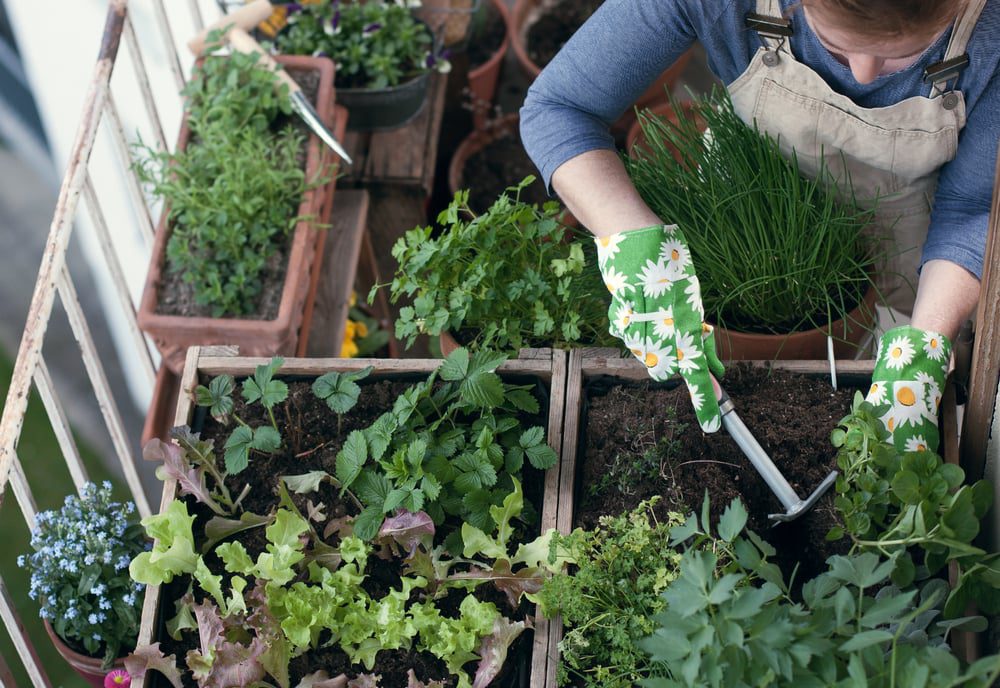
Many herb plants, with their strong scents and flowers attractive to beneficial insects are naturally suited to growing near tomatoes. The right herbs can improve flavor while repelling pests and feeding predatory insects.
Basil
Few pairings are as time-tested as tomatoes with basil. As a warm season annual it thrives alongside tomatoes and research supports enhanced fruit flavor and production. Interplant or place basil pots nearby. Choose from spice-scented African blue basil, cinnamon basil, lemon basil and more.
Chives
As part of the allium family, chives work to repel aphids, beetles and carrot flies. Allow some purple chive flowers to bloom to attract beneficial insects. Snip chives frequently to encourage growth.
Cilantro
This cool season annual grows well with tomatoes into late spring and again for fall crops. It’s lacy foliage doesn’t compete much. A light cilantro scent may help confuse pests. But beware allowing it to bolt and go to seed!
Dill
Useful as a trap crop for pickleworms, cabbage worms and tomato hornworms which feast on dill foliage and avoid the tomatoes. It’s tall spiky tops will not compete for light. An added benefit – harvest some dill heads for pickling.
Marigolds
A go-to for companion planting, marigolds have root exudates suppressive to nematodes and other pests. French marigolds are smaller and neater near/under tomatoes. Larger American marigolds require more room between plants.
Oregano & Marjoram
With aromatic oils toxic to many pests, these related Mediterranean natives help protect tomatoes. Their low bushes fill space efficiently too. Crush a leaf occasionally to release more scent.
Thyme
This relative of mint also enjoys hot sun and intensive cultivation. Interplant with tomatoes or use as edging. The active oils in thyme aid the tomatoe’s disease resistance. Lemon thyme varieties offer the strongest scent.
Best Flower Companion Plants for Tomatoes
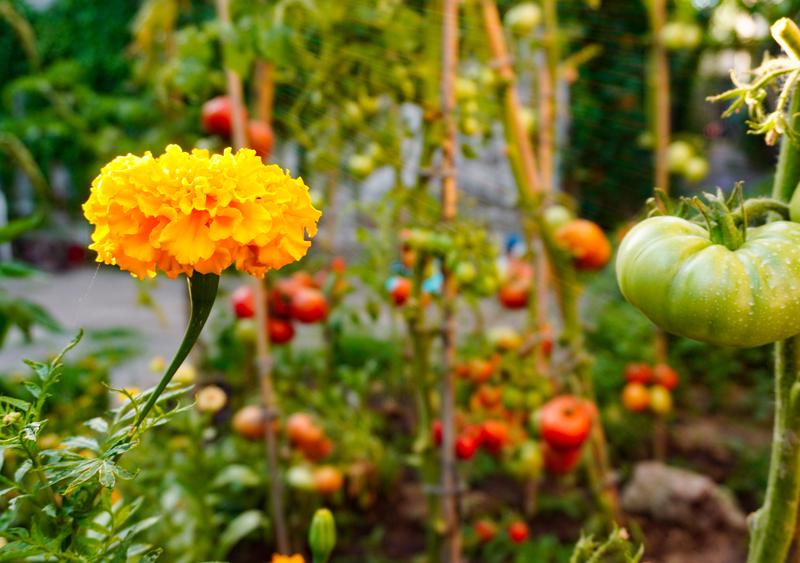
Adding flowers around or amongst vegetable crops provides color and attracts important pollinators and beneficial insects that prey on common tomato pests. Choose prolific bloomers best suited to summer heat.
Cosmos
Fast-growing, long-blooming annuals that favor full sun. The daisy-like blooms in pinks, purples and whites draw in ladybugs, lacewings and hoverflies. One of the very best at attracting tachinid flies that parasitize tomato hornworms.
Nasturtiums
No list of tomato companions is complete without this edible annual flower. Trailing, mounding and climbing types are all useful. Pepper-flavored leaves and vibrant orange or red flowers that hummingbirds love. Known to repel various beetles, aphids and whiteflies too.
Sunflowers
While needing more space, sunflowers planted around the vegetable garden periphery provide huge splashes of bright yellow and pollen-laden flowers so enticing to beneficial insects like green lacewings. Some newer dwarf types work amongst beds.
Sweet Alyssum
A goto small scale annual companion for any garden. Masses of tiny white blooms nourish minute pirate bugs, big-eyed bugs, hoverflies and other tiny helpful insects that munch on thrips, mites and eggs of pest species. Tolerates shade well also.
Zinnias
Easy to grow from seed and coming in a rainbow of colors and sizes from 6 inches to over 3 feet tall, there is a zinnia suited to every garden space. Butterflies cannot resist these daisy-like blooms which support predators like paper wasps. Choose disease resistant varieties.
Best Vegetables & Fruit Companion Plants for Tomatoes
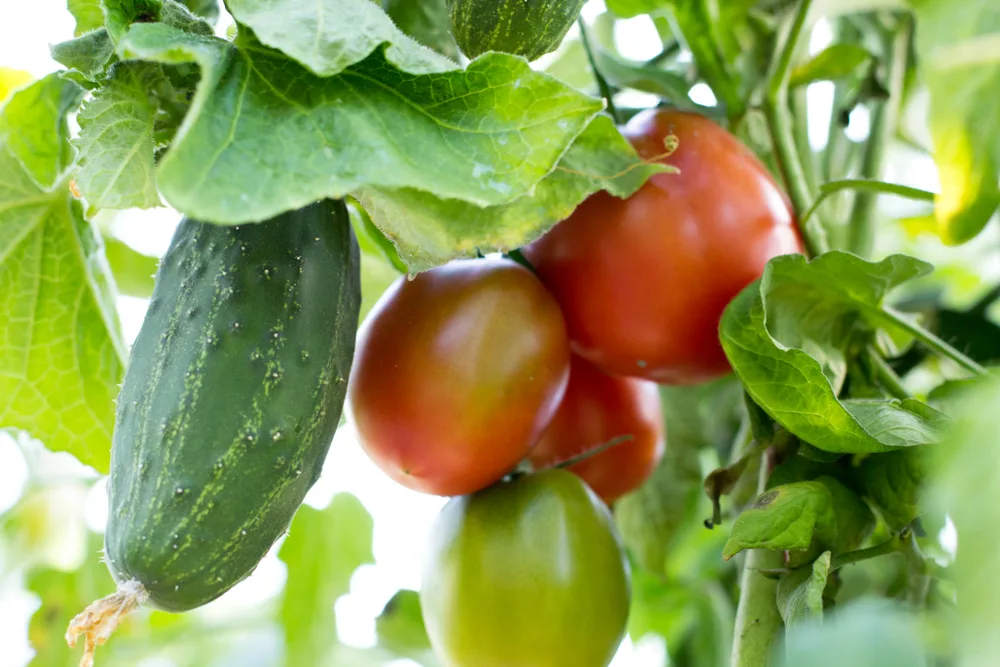
Just as herbs and flowers can enhance tomatoe’s growth and productivity, other fruits and vegetables make great companions too. These are largely guided by environmental synergies created with tomatoes.
- Asparagus – A perennial that offers early spring roots to balance heavy summer growth and fruiting in tomatoes. Different nutrient needs and root depths improve soil structure over time. Asparagus beetles dislike tomatoes.
- Beans (Pole varieties) – The quintessential companion thriving under the larger tomato plants. Beans fix nitrogen from air into soils and don’t compete for nutrients. Bean flowers also attract beneficial insects to protect tomatoes. Choose beans thriving in summer heat.
- Carrots & Onions – Classic root crop companions suited for planting between tomato plants. Shallow rooted carrots and bulbing onions don’t compete much for water and nutrients. Onions masking the scent of carrots to reduce carrot flies are a model trap crop too.
- Peppers – Close tomato relatives that share optimal growing conditions and pests. Interplanting creates efficiency and potential confusion for tomato hornworm moths seeking the right host plant. Select peppers ripening at different times than main tomato crop.
- Radishes – Perfect for planting between tomato rows every 2-3 weeks for an continuous crop. Fast growing radishes are ready to harvest just as tomato plants require more root space. By summer’s end a nicely raised bed results.
- Strawberries – An ideal fruit companion thriving under the dappled shade of tomato foliage. Protects berries from birds too. Both crops enjoy steady moisture and strawberries rarely spread enough to impede tomato roots. Just beware verticillium wilt susceptibility.
Companion Planting Tips & Best Practices
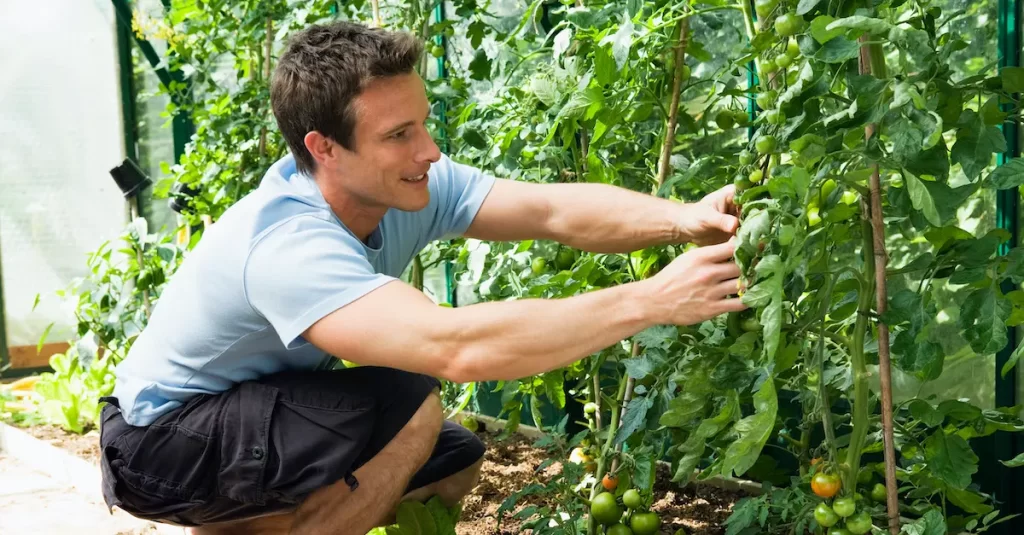
Follow these simple guidelines as you select and place companion plants with your tomatoes to get the most benefits:
- Know plant spacing needs – Give all plants room for growth to maturity size. Approximate size at maturity before planting.
- Increase diversity – Choose plants with different growth habits, bloom times, pest & disease resistance that suit local conditions
- Use efficient geometries – Place taller plants where they won’t shade low growers. Lean pole bean trellises northwards to avoid shading.
- Blend compatible plants – Match crop rotation needs and consider sun vs part-shade tolerances. Most tomato companions like full sun.
- Time plantings well – Cool season crops 1-2 months before warm season ones when soils approach 60F. Herbs & flowers 1-2 weeks after frost free date.
- Try novel combinations – Creativity and observation are key! Keep notes and tweak things yearly as you learn more about specific companion relationships.
Continually experimenting with new companion planting combinations allows you to create an increasingly symbiotic, diverse and resilient tomato growing environment. Pay attention to what seems to be working best and replicate it again the next season. Soon you’ll have a thriving, largely self-sustaining tomato and companion garden you can enjoy for years to come.
FAQs
Some excellent companion plants for deterring tomato hornworms include dill, chamomile and marigolds. Dill attracts hornworms and keeps them off your tomato plants. Marigold root secretions repel them and chamomile can reduce egg laying by the hornworm moths.
While not the closest of allies, cucumbers and tomatoes actually do pretty well together. They occupy different areas of the garden bed and don’t compete much for nutrients. Cucumbers do well grown vertically on a trellis alongside staked tomatoes. Separate any vining cucumbers by at least 6 feet though.
A few things like sage, rue and camphor basil should not be planted near common sweet basil. Sage and rue in particular discourage beneficial insects. Cilantro and parsley can be grown with basil but keep them a few feet apart to avoid potential issues from damping off soil fungi.
Some great options for planting with both tomatoes and peppers include parsley, onions, garlic, carrots, Swiss chard, bush beans, celery and lovage. These mostly shallow rooted plants don’t compete much for moisture and nutrients. Their differing pest and disease resistance improves the whole crop.
Many gardeners find borage does enhance tomato flavor and growth. The theory is that particular biochemicals produced by borage accumulate in nearby tomato plant tissues. For best effects plant borage every few feet around or throughout the tomato bed so they are close but not touching the tomato plants.
Conclusion
The concepts behind thoughtfully integrating companion plants amongst your tomato crop may seem complicated at first. But the symbiotic benefits are grounded in sound science – even if the mechanisms are not always fully understood. Leveraging these symbioses leads to healthier plants, fewer pests, bigger yields and even better tasting tomatoes. Start simply with a few trusted tomato companion recommendations that suit your local growing conditions. Then expand and experiment further as the seasons allow. Soon you’ll have evidence of your own on which combinations create optimal environments for maximum tomato productivity and enjoyment.


